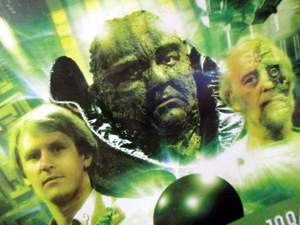Four to Doomsday
“Ah, conformity. There is no other freedom.” – Monarch
 There are some good ideas presented in this story but the writing is extremely sloppy—full of shifting motivations, mischaracterizations, unclear explanations, and a very anticlimactic ending. (It doesn’t help that there is stilted direction and some shoddy special effects as well.) There’s even a clunky exposition of the entire premise of Doctor Who inserted into episode three. Overall, however, it’s an interesting start to a storyline: an alien ship has visited earth multiple times back and forth over the centuries collecting specimens from various parts of the earth at different periods which are now kept alive as android beings. This allows for the story to insert an appealing mix of cultures (even though all a bit stereotyped). Indeed, taken by itself the Aboriginal dance (no idea if it’s authentic) is quite entertaining.
There are some good ideas presented in this story but the writing is extremely sloppy—full of shifting motivations, mischaracterizations, unclear explanations, and a very anticlimactic ending. (It doesn’t help that there is stilted direction and some shoddy special effects as well.) There’s even a clunky exposition of the entire premise of Doctor Who inserted into episode three. Overall, however, it’s an interesting start to a storyline: an alien ship has visited earth multiple times back and forth over the centuries collecting specimens from various parts of the earth at different periods which are now kept alive as android beings. This allows for the story to insert an appealing mix of cultures (even though all a bit stereotyped). Indeed, taken by itself the Aboriginal dance (no idea if it’s authentic) is quite entertaining.
This sci-fi idea leads to other interesting notions such as the robotized Urbankans now referring to their previous state as ‘the Flesh Time.’ Their cold description of it (“The time of the chickenpox, of hunger and heart disease, arthritis, bronchitis and the common cold.”) and the debate with Nyssa over their acceptance of mindless tyranny is probably one of the better written scenes in the story. My one complaint is that the emotion of the statements is lost when the characters speaking them appear so lifelike that it is not obvious that they are machines. While this is supposed to be the point (the Urbankan technology is so advanced that machine and organism are indistinguishable), imagine how much more powerful the argument would be coming from the cold metal faces of the Cyberman or Daleks.
We get to see some of the character of the new Doctor in his unceasingly polite wordplay with Monarch at their first meeting. Even when riled, he is quite proper until he reaches that bit of voice-breaking exasperation. Unfortunately, the others in the story don’t come off so well—Adric is unbelievably gullible, Tegan unrealistically stubborn, and Nyssa overly passive. This story really needed to set a strong start for the large TARDIS crew but it actually sets them back quite a bit. Every other character in the story is inconsistent as well. Monarch seems enamored of the Doctor’s intelligence and “mental anarchy” and then suddenly acts as if he has seen it as a threat all along; he approves of Bigon’s lack of conformity (“We need doubt”) and then is incensed about it. At times, he’s curious and others megalomaniacal. The converted Earth beings are also inconsistent—at one point greed-driven and evil and then suddenly easily won over and acting as if they had always been best friends.
Though there are a few good tries at new effects with the monopitcons and Bigon’s circuitry, some very bad costuming and design (The space helmets! The converter helmet! The space walk!) ruin it as does some overacting. In all, the story just does not come together.
Best (or worst) unsettling moment:
The story creates a nice initial underlying menace when the Aboriginal Kurkutji speaks of “going walkabout to the dreaming” or, as Tegan points out, “Heaven. He says he’s going to heaven. We’re all going to heaven!” Another startling moment comes early on when we the characters we just saw Tegan draw on paper suddenly walk into the room. Their adopted names of Persuasion and Enlightenment give them a certain mystique.
Firsts:
- The Doctor tries to take Tegan back to Heathrow—and misses. (The first of many)
- The Doctor is carrying a cricket ball
Regrets:
A good idea but not well-written or designed and thus forgettable.
